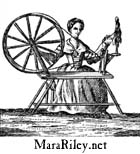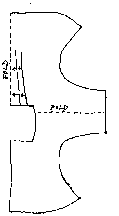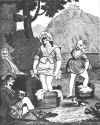 |
||
|
Shortgowns (or, as they seem to appear most often in 18th century references, short gowns) seem to have been worn in from the 3rd quarter of the 18th century into the early 19th century, so are not generally appropriate for F&I -- for the earlier part of the century, bedgowns are more appropriate. There is some debate as to whether shortgowns are strictly a Pennsylvania German/Quaker garment, but there is evidence that they were worn elsewhere in the Colonies (Ohio, Virginia, Connecticut, New York, the Caribbean) and Europe as well (see Claudia Kidwell's article, cited below). The shortgown seems to have developed from draped garments (the mantua, the bedgown) worn earlier in the century, as it is cut out of one piece of fabric and then fitted to the body with pleats and/or drawstrings. As such, there is a fair amount of variation among these garments. Design: Many existing shortgowns have vertical pleats tucked into the back (and sometimes the front) to make the garment more fitted and flattering. Some are pieced, to make the available material go further. They can be lined or unlined. Most late 18th century shortgowns are about hip-length, though there are some longer mid-thigh-length examples. Sleeves are usually just below elbow-length, though some later examples reach to the wrist. Materials: Below is a diagram for drafting your own shortgown. You can alter the pattern as needed for fashion (most early 19th century shortgowns were shortwaisted, following the fashion of the time, worn with petticoats that were held up at the higher waistline with straps over the shoulders). Shortgown patterns are also available from several sources, including Burnley & Trowbridge and J.P. Ryan.
|
||
| (better drawing coming soon) |
Measurements needed: __ length from the shoulder fold to the hem __ Waist: width of torso at waistline (or raised waistline, for early 19th c. styles), plus 2" to 3" for ease __ width from the back center line to about 1-2" below your elbow __ circumference of your arm just below the elbow, plus about 2" __ width of neckline: measure from center line to about 3" in from shoulder __ depth of neckline in front: measure from top of shoulder to about 1-2" above top of stays (depth of neckline in back should be about 2" to 3") |
|
|
|
Is this woman wearing a shortgown? Hard to say from a sketch, but sure looks like it to me... (Early 19th c. engraving showing Scottish washerwomen tramping their laundry) |
|
|
Burnston, Sharon Ann. Fitting & Proper: 18th Century Clothing from the Collection of the Chester County Historical Society, Scurlock Publishing Co., 1998. Gehret, Ellen J. Rural Pennsylvania Clothing, Liberty Cap Books, 1976. Hersh, Tandy and Charles, Cloth and Costume 1750 to 1800: Cumberland County, Pennsylvania, Cumberland County Historical Society, 1995. Huesken, Sue and Karen Mullian, Had On and Took With Her: Female Runaway Servant Advertisements in the Pennsylvania Evening Post, 1774-1784. SK Research, Palmyra, New Jersey, 1995, 2003. Kidwell, Claudia. Short Gowns, in Dress: The Journal of the Costume Society of America, Vol. 4/1978. Riley, Mara, Whatever Shall I Wear? A guide to assembling a woman's basic 18th century wardrobe. Graphics/Fine Arts Press, 2002. |
||
|
|
||


